Studies in Hysteria
Blanche Wittman in André Brouillet's
portrait of Dr. Charcot and Dr. Babinski demonstrating hypnosis, A Clinical Lecture at the
Salpêtiere, 1887 (L'Ecole de Medecine, Lyon,
France)
Vocabulary
abasia
(148, 156)
abreact
(135), abreaction
(152)
analgesia
(109)
anosmia
(122)
antipyrin
injection (73)
astasia-abasia
(169, 178)
athetosis
(51)
la
belle indifférence (139)
bran
bath (57)
capercaillie
(96)
caries
of the ethmoid
(109, 119)
catalepsy
(111)
cathected
(84)
cathexis
(156)
chorea
(147)
délire ecmnésique (180) = a state of delirium in which
the patient thinks she's reliving an old experience
faradic
brush (68)
faradization
(142)
hyperalgesia
(140)
hysteria
= conversion
disorder
ideational
content (169)
idées fixes (92) = fixed idea, obsession
misère psychologique (96) = psychological trouble
naso-labial
folds (51)
neuralgia
oedema (144) = edema,
dropsy
paraphasia
(29)
paresis
(27)
paretic
(43)
peripleuritic
(26)
retroverted
uterus (72)
sub-pleural abscess (42) = abscess beneath the pleura
suppurative
rhinitis
(109)
zoöpsia (63) = hallucination of animals
1. What does hysteria say about family, gender relations at
the
end of the 19th century?
2. What does it signify to identify a
woman or a man as an hysteric?
What's at stake in being an hysteric?
3. In what ways is the hysteric a
solution (or not) to the
dilemmas of the New Woman?
4. What is the scholarly debate
around hysteria at the end of
the 19th century?

